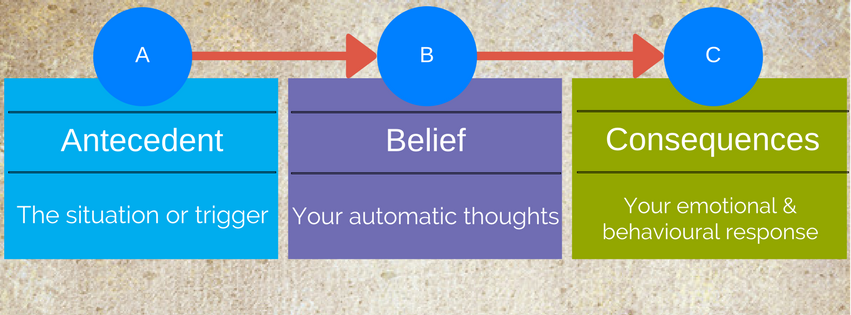The SANE Blog
Changing thinking styles for better mental health
How does the way we think influence the way we feel? What goes on in our minds – both consciously and unconsciously – and how do our thoughts impact on our mental health?
Maybe you’ve reacted to events in ways that cannot be explained rationally and just seem to make everything worse. You’ve probably felt confused and frustrated by your actions or emotional responses.
If you’ve ever felt like this, there are ways to better understand and manage your reactions.
Cognitive Behavioural Therapy (CBT) is one approach that can help you identify and change the negative thinking patterns that influence these responses.
What is Cognitive Behavioural Therapy?
CBT explores how a person’s thoughts, feelings and behaviours interact and the impact this has on everyday life. The ‘ABC’ model shows how our thoughts influence our emotional and behavioural reactions to situations.

The model suggests that people in identical circumstances can react differently depending on their thinking styles. For example, if you wave to a friend and they don’t wave back, the way you think will influence your emotional reaction. Thinking ‘maybe they didn’t see me’ is unlikely to provoke a strong reaction, whereas thinking ‘they must hate me’ may bring up negative feelings.
Unhelpful thinking styles
Everyone develops their own patterns of thinking that apply in many situations. These unhelpful thinking styles are learnt though life experiences and are linked to our beliefs about ourselves, others and the world.
Negative thinking patterns can distort our view of reality, leading to distress and self-defeating behaviours that keep people ‘stuck’ in vicious cycles. In the example above, interpreting a friend not waving back as ‘they must hate me’ could lead to feelings of sadness and shame, and a loss of confidence to approach others for fear of further rejection. Such withdrawal could reinforce beliefs of being disliked by others, perpetuating distress.
It’s important to remember that we don’t take on these unhelpful thinking styles on purpose – our thoughts in response to situations are so rapid we don’t even notice them. We are left feeling distressed and confused, not knowing why we reacted this way. This is because our automatic patterns of thinking are learnt over our lifetime and used everyday. They become a habit and are not recognised by our conscious mind. This means that adjusting these responses is a challenge, but there are ways to do this.
Change thinking patterns and start feeling better!
So, how can we change these unhelpful cycles? The first step is to become aware of our negative automatic thoughts.
Thought monitoring records can be a good tool to start with. By taking the time to record our thoughts when we feel distressed, we can identify our triggers and unhelpful thinking styles. Doing this interrupts the automatic thought process and creates some distance from distressing beliefs.
Once we start noticing our negative thoughts, we can either challenge them, by evaluating the evidence and creating a more realistic point of view, or we can mindfully acknowledge them, recognise that they are just thoughts, then decide what action to take. Cultivating new, more flexible ways of thinking can help us break free from cycles of distress and improve our mood. Seeking support from a counsellor, or psychologist, can be helpful while learning these new skills.
There is strong evidence that CBT is an effective treatment in helping people recover from mental illness, and can help change your brain. Rewiring your brain requires persistence. If you have been thinking a certain way for your entire life, it’s going to take a while for new patterns of thinking to become habitual! But remember, the payoff can be life changing, as understanding the way our minds work can improve our overall mental health.
More to read...
- Definition of CBT by the Australian Association for Cognitive and Behaviour Therapy
- Unhelpful thinking styles by the Centre for Clinical Interventions provides worksheets for a number of unhelpful thinking styles
- Free online training modules to help you understand and change the way you think
- Cognitive behavioural therapy can change your brain article on the benefits of CBT
SANE provides a range of free telephone and online support services for people over 18 years of age with complex mental health needs and their family, friends and carers. We offer different types and levels of support so you can find what works for you. Choose from counselling, peer support, online groups and events, 24/7 community forums, and online information and resources. Learn more at sane.org/get-support.
When you subscribe to the blog, we will send you an e-mail when there are new updates on the site so you wouldn't miss them.
